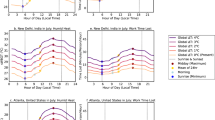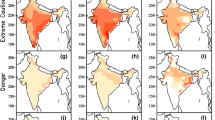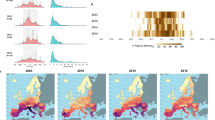Abstract
Heat stress at the workplace is an occupational health hazard that reduces labour productivity1. Assessment of productivity loss resulting from climate change has so far been based on physiological models of heat exposure1. These models suggest productivity may decrease by 11–27% by 2080 in hot regions such as Asia and the Caribbean2, and globally by up to 20% in hot months by 20503. Using an approach derived from health economics, we describe self-reported estimates of work absenteeism and reductions in work performance caused by heat in Australia during 2013/2014. We found that the annual costs were US$655 per person across a representative sample of 1,726 employed Australians. This represents an annual economic burden of around US$6.2 billion (95% CI: 5.2–7.3 billion) for the Australian workforce. This amounts to 0.33 to 0.47% of Australia’s GDP. Although this was a period when many Australians experienced what is at present considered exceptional heat4, our results suggest that adaptation measures to reduce heat effects should be adopted widely if severe economic impacts from labour productivity loss are to be avoided if heat waves become as frequent as predicted.
This is a preview of subscription content, access via your institution
Access options
Subscribe to this journal
Receive 12 print issues and online access
$209.00 per year
only $17.42 per issue
Buy this article
- Purchase on Springer Link
- Instant access to full article PDF
Prices may be subject to local taxes which are calculated during checkout

Similar content being viewed by others
References
Parsons, K. Human Thermal Environments (CRC Press, 2014).
Kjellstrom, T., Kovats, R. S., Lloyd, S. J., Holt, T. & Tol, R. S. J. The direct impact of climate change on regional labor productivity. Arch. Environ. Occup. Health 64, 217–227 (2009).
Dunne, J. P., Stouffer, R. J. & John, J. G. Reductions in labour capacity from heat stress under climate warming. Nature Clim. Change 3, 563–566 (2013).
Special Climate Statements (Bureau of Meteorology, accessed December 2014); http://www.bom.gov.au/climate/current/statements.
Stern, N. The structure of economic modeling of the potential impacts of climate change: Grafting gross underestimation of risk onto already narrow science models. J. Econ. Lit. 51, 838–859 (2013).
Morabito, M., Cecchi, L., Crisci, A., Modesti, P. A. & Orlandini, S. Relationship between work-related accidents and hot weather conditions in Tuscany (central Italy). Ind. Health 44, 458–464 (2006).
Tawatsupa, B. et al. Association between heat stress and occupational injury among Thai workers: Findings of the Thai cohort study. Ind. Health 51, 34–46 (2013).
Tamm, M. et al. The compression of perceived time in a hot environment depends on physiological and psychological factors. Q. J. Exp. Psychol. 67, 197–208 (2014).
McMorris, T. et al. Heat stress, plasma concentrations of adrenaline, noradrenaline, 5-hydroxytryptamine and cortisol, mood state and cognitive performance. Int. J. Psychophysiol. 61, 204–215 (2006).
Gaoua, N., Racinais, S., Grantham, J. & El Massioui, F. Alterations in cognitive performance during passive hyperthermia are task dependent. Int. J. Hyperthermia 27, 1–9 (2011).
Kjellstrom, T., Gabrysch, S., Lemke, B. & Dear, K. The ‘Hothaps’ programme for assessing climate change impacts on occupational health and productivity: An invitation to carry out field studies. Glob. Health Action 2 http://dx.doi.org/10.3402/gha.v2i0.2082 (2009).
Smith, K. R. et al. in Climate Change 2014: Impacts, Adaptation, and Vulnerability (eds Field, C. B. et al.) 709–754 (IPCC, Cambridge Univ. Press, 2014).
Miller, V., Bates, G., Schneider, J. D. & Thomsen, J. Self-pacing as a protective mechanism against the effects of heat stress. Ann. Occup. Hyg. 55, 548–555 (2011).
Sahu, S., Sett, M. & Kjellstrom, T. Heat exposure, cardiovascular stress and work productivity in rice harvesters in India: Implications for a climate change future. Ind. Health 51, 424–431 (2013).
Hübler, M., Klepper, G. & Peterson, S. Costs of climate change—the effects of rising temperatures on health and productivity in Germany. Ecol. Econ. 68, 381–393 (2008).
Budd, G. M. Wet-bulb globe temperature (WBGT)—its history and its limitations. J. Sci. Med. Sport 11, 20–32 (2008).
Zhang, W., Bansback, N. & Anis, A. H. Measuring and valuing productivity loss due to poor health: A critical review. Soc. Sci. Med. 72, 185–192 (2011).
Reilly, M. C., Zbrozek, A. S. & Dukes, E. M. The validity and reproducibility of a work productivity and activity impairment instrument. Pharmacoeconomics 4, 353–365 (1993).
Lofland, J. H., Pizzi, L. & Frick, K. D. A review of health-related workplace productivity loss instruments. Pharmacoeconomics 22, 165–184 (2004).
Xiang, J., Bi, P., Pisaniello, D. & Hansen, A. The impact of heatwaves on workers, health and safety in Adelaide, South Australia. Environ. Res. 133, 90–95 (2014).
Coates, L., Haynes, K., O’Brien, J., McAneney, J. & de Oliveira, F. D. Exploring 167 years of vulnerability: An examination of extreme heat events in Australia 1844–2010. Environ. Sci. Policy 42, 33–44 (2014).
Alexander, L. V. & Arblaster, J. M. Assessing trends in observed and modelled climate extremes over Australia in relation to future projections. Int. J. Climatol. 29, 417–435 (2009).
Perkins, S. E., Alexander, L. V. & Nairn, J. R. Increasing frequency, intensity and duration of observed global heatwaves and warm spells. Geophys. Res. Lett. 39, L20714 (2012).
Reisinger, A. et al. in Climate Change 2014: Impacts, Adaptation, and Vulnerability (eds Field, C. B. et al.) 1371–1438 (IPCC, Cambridge Univ. Press, 2014).
Zivin, J. G. & Neidell, M. Temperature and the allocation of time: Implications for climate change. J. Labor Econ. 32, 1–26 (2014).
Stone, A. A., Bachrach, C. A., Jobe, J. B., Kurtzman, H. S. & Cain, V. S. (eds) The Science of Self-Report: Implications for Research and Practice (Lawrence Erlbaum Associates, 1999).
Li, X., Gignac, M. A. M. & Anis, A. H. The indirect costs of arthritis resulting from unemployment, reduced performance, and occupational changes while at work. Med. Care 44, 304–310 (2006).
Maniadakis, N. & Gray, A. The economic burden of back pain in the UK. Pain 84, 95–103 (2000).
Australian Bureau of Statistics (ABS), 2011 Census of Population and Housing (Commonwealth of Australia, 2012).
Ng, T. W. H. & Feldman, D. C. The relationship of age to ten dimensions of job performance. J. Appl. Psychol. 93, 392–423 (2008).
Singh, S., Hanna, E. G. & Kjellstrom, T. Working in Australia’s heat: Health promotion concerns for health and productivity. Health Promot. Int. http://dx.doi.org/10.1093/heapro/dat027 (2013).
Landy, S. H., Runken, M. C., Bell, C. F., Higbie, R. L. & Haskins, L. S. Assessing the impact of migraine onset on work productivity. J. Occup. Environ. Med. 53, 74–81 (2011).
Rowlinson, S., YunyanJia, A., Li, B. & ChuanjingJu, C. Management of climatic heat stress risk in construction: A review of practices, methodologies, and future research. Accid. Anal. Prev. 66, 187–198 (2014).
Yi, W. & Chan, A. Optimal work pattern for construction workers in hot weather: A case study in Hong Kong. J. Comput. Civ. Eng. http://dx.doi.org/10.1061/(ASCE)CP.1943-5487.0000419 (2014).
Kamerman, S. B. & Kahn, A. J. The Responsive Workplace: Employers and a Changing Labor Force (Columbia Univ. Press, 2013).
Rudmik, L. et al. Productivity costs in patients with refractory chronic rhinosinusitis. Laryngoscope http://dx.doi.org/10.1002/lary.24630 (2014).
Stewart, W. F., Ricci, J. A., Chee, E., Hahn, S. R. & Morganstein, D. Cost of lost productive work time among US workers with depression. J. Am. Med. Assoc. 289, 3135–3144 (2003).
Burton, W. N., Conti, D. J., Chen, C-Y., Schultz, A. B. & Edington, D. W. The economic burden of lost productivity due to migraine headache: A specific worksite analysis. JOEM 44, 523–529 (2002).
Osterhaus, J., Gutterman, D. & Plachetka, J. Healthcare resource and lost labour costs of migraine headache in the US. PharmacoEconomics 2, 67–76 (1992).
Cull, R. E., Wells, N. E. J. & Miocevich, M. L. The conomic cost of migraine. Br. J. Med. Econ. 2, 103–115 (1992).
Serrano, D. et al. Cost and predictors of lost productive time in chronic migraine and episodic migraine: Results from the American Migraine Prevalence and Prevention (AMPP) study. Value Health 16, 31–38 (2013).
Edmeads, J. & Mackell, J. A. The economic impact of migraine: An analysis of direct and indirect costs. Headache 42, 501–509 (2002).
Stuhldreher, N. et al. The costs of social anxiety disorder: The role of symptom severity and comorbidities. J. Affect. Disord. 165, 87–94 (2014).
Bunn, W. B., Stave, G. M., Downs, K. E., Alvir, J. M. & Dirani, R. Effect of smoking status on productivity loss. J. Occup. Environ. Med. 48, 1099–1108 (2006).
Rosekind, M. R. et al. The cost of poor sleep: workplace productivity loss and associated costs. J. Occup. Env. Med. 52, 91–98 (2010).
Ainsworth, B. E. et al. Recommendations to improve the accuracy of estimates of physical activity derived from self report. J. Phys. Act. Health 9, 76–84 (2012).
Acknowledgements
The project was funded from two internal research grants from the Faculty of Law, Education, Business and Arts (LEBA) at Charles Darwin University.
Author information
Authors and Affiliations
Contributions
K.K.Z., E.O. and S.T.G. designed the survey. K.K.Z. analysed the data and wrote the first version of the manuscript with the help of S.T.G. W.J.W.B. helped interpret the data and results and provided technical and conceptual advice. T.K. provided conceptual advice. All authors contributed to improving and revising the paper.
Corresponding author
Ethics declarations
Competing interests
The authors declare no competing financial interests.
Supplementary information
Rights and permissions
About this article
Cite this article
Zander, K., Botzen, W., Oppermann, E. et al. Heat stress causes substantial labour productivity loss in Australia. Nature Clim Change 5, 647–651 (2015). https://doi.org/10.1038/nclimate2623
Received:
Accepted:
Published:
Issue Date:
DOI: https://doi.org/10.1038/nclimate2623
This article is cited by
-
Evaluating long-term and high spatiotemporal resolution of wet-bulb globe temperature through land-use based machine learning model
Journal of Exposure Science & Environmental Epidemiology (2023)
-
Responses to heat waves: what can Twitter data tell us?
Natural Hazards (2023)
-
Compound heatwave and drought hotspots and their trends in Southeast Australia
Natural Hazards (2023)
-
Topic modelling the mobility response to heat and drought
Climatic Change (2023)
-
A quantitative approach to human-thermal vulnerability
Theoretical and Applied Climatology (2023)



